Managing Multiculturalism and Diversity in the Australian Workplace
VerifiedAdded on 2022/09/22
|5
|1653
|20
Essay
AI Summary
This essay examines multiculturalism in Australia, highlighting its historical context, diverse population, and the opportunities and challenges it presents in the workplace. It discusses how multiculturalism has enriched the Australian society, fostering a diverse workforce, generating new skills, and promoting innovation. The essay also addresses challenges such as breaches of trust, cultural conflicts, and the impact on personal values. It emphasizes the importance of effective diversity management for businesses to serve a diverse customer base and adapt to cultural differences. The conclusion underscores the significance of multiculturalism in shaping the Australian society and the need to address the ongoing challenges to promote a harmonious and productive work environment.
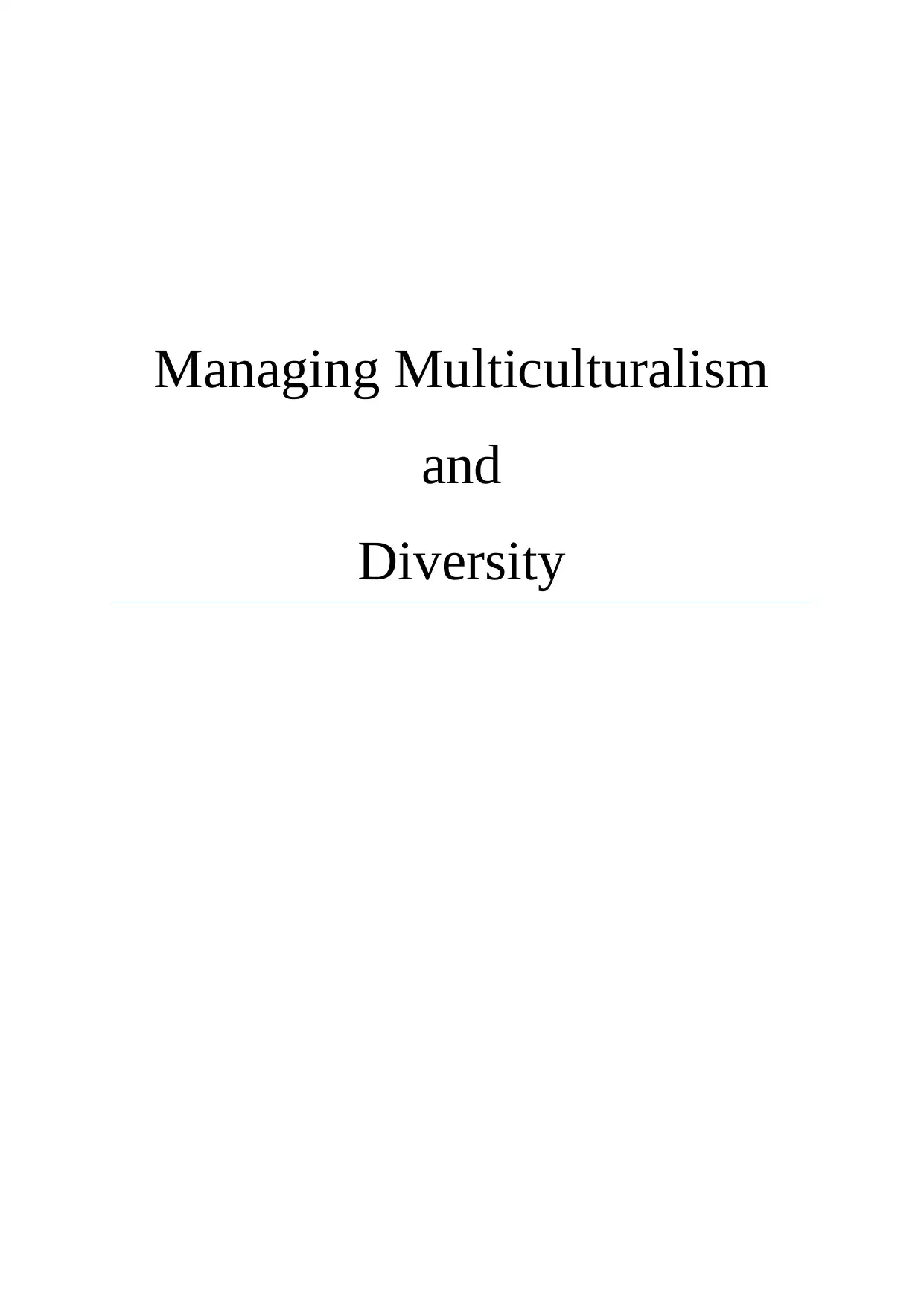
Managing Multiculturalism
and
Diversity
and
Diversity
Paraphrase This Document
Need a fresh take? Get an instant paraphrase of this document with our AI Paraphraser
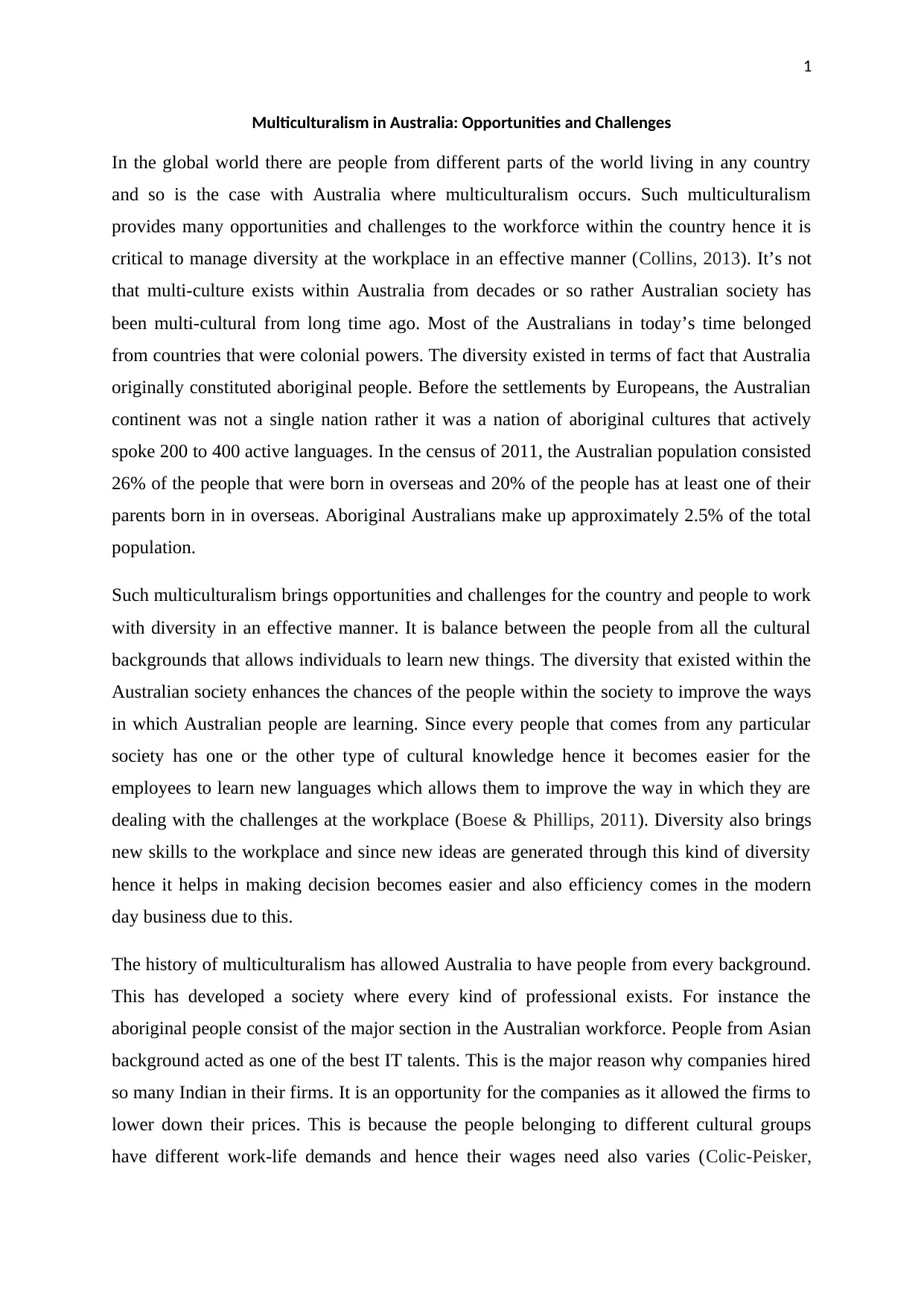
1
Multiculturalism in Australia: Opportunities and Challenges
In the global world there are people from different parts of the world living in any country
and so is the case with Australia where multiculturalism occurs. Such multiculturalism
provides many opportunities and challenges to the workforce within the country hence it is
critical to manage diversity at the workplace in an effective manner (Collins, 2013). It’s not
that multi-culture exists within Australia from decades or so rather Australian society has
been multi-cultural from long time ago. Most of the Australians in today’s time belonged
from countries that were colonial powers. The diversity existed in terms of fact that Australia
originally constituted aboriginal people. Before the settlements by Europeans, the Australian
continent was not a single nation rather it was a nation of aboriginal cultures that actively
spoke 200 to 400 active languages. In the census of 2011, the Australian population consisted
26% of the people that were born in overseas and 20% of the people has at least one of their
parents born in in overseas. Aboriginal Australians make up approximately 2.5% of the total
population.
Such multiculturalism brings opportunities and challenges for the country and people to work
with diversity in an effective manner. It is balance between the people from all the cultural
backgrounds that allows individuals to learn new things. The diversity that existed within the
Australian society enhances the chances of the people within the society to improve the ways
in which Australian people are learning. Since every people that comes from any particular
society has one or the other type of cultural knowledge hence it becomes easier for the
employees to learn new languages which allows them to improve the way in which they are
dealing with the challenges at the workplace (Boese & Phillips, 2011). Diversity also brings
new skills to the workplace and since new ideas are generated through this kind of diversity
hence it helps in making decision becomes easier and also efficiency comes in the modern
day business due to this.
The history of multiculturalism has allowed Australia to have people from every background.
This has developed a society where every kind of professional exists. For instance the
aboriginal people consist of the major section in the Australian workforce. People from Asian
background acted as one of the best IT talents. This is the major reason why companies hired
so many Indian in their firms. It is an opportunity for the companies as it allowed the firms to
lower down their prices. This is because the people belonging to different cultural groups
have different work-life demands and hence their wages need also varies (Colic-Peisker,
Multiculturalism in Australia: Opportunities and Challenges
In the global world there are people from different parts of the world living in any country
and so is the case with Australia where multiculturalism occurs. Such multiculturalism
provides many opportunities and challenges to the workforce within the country hence it is
critical to manage diversity at the workplace in an effective manner (Collins, 2013). It’s not
that multi-culture exists within Australia from decades or so rather Australian society has
been multi-cultural from long time ago. Most of the Australians in today’s time belonged
from countries that were colonial powers. The diversity existed in terms of fact that Australia
originally constituted aboriginal people. Before the settlements by Europeans, the Australian
continent was not a single nation rather it was a nation of aboriginal cultures that actively
spoke 200 to 400 active languages. In the census of 2011, the Australian population consisted
26% of the people that were born in overseas and 20% of the people has at least one of their
parents born in in overseas. Aboriginal Australians make up approximately 2.5% of the total
population.
Such multiculturalism brings opportunities and challenges for the country and people to work
with diversity in an effective manner. It is balance between the people from all the cultural
backgrounds that allows individuals to learn new things. The diversity that existed within the
Australian society enhances the chances of the people within the society to improve the ways
in which Australian people are learning. Since every people that comes from any particular
society has one or the other type of cultural knowledge hence it becomes easier for the
employees to learn new languages which allows them to improve the way in which they are
dealing with the challenges at the workplace (Boese & Phillips, 2011). Diversity also brings
new skills to the workplace and since new ideas are generated through this kind of diversity
hence it helps in making decision becomes easier and also efficiency comes in the modern
day business due to this.
The history of multiculturalism has allowed Australia to have people from every background.
This has developed a society where every kind of professional exists. For instance the
aboriginal people consist of the major section in the Australian workforce. People from Asian
background acted as one of the best IT talents. This is the major reason why companies hired
so many Indian in their firms. It is an opportunity for the companies as it allowed the firms to
lower down their prices. This is because the people belonging to different cultural groups
have different work-life demands and hence their wages need also varies (Colic-Peisker,
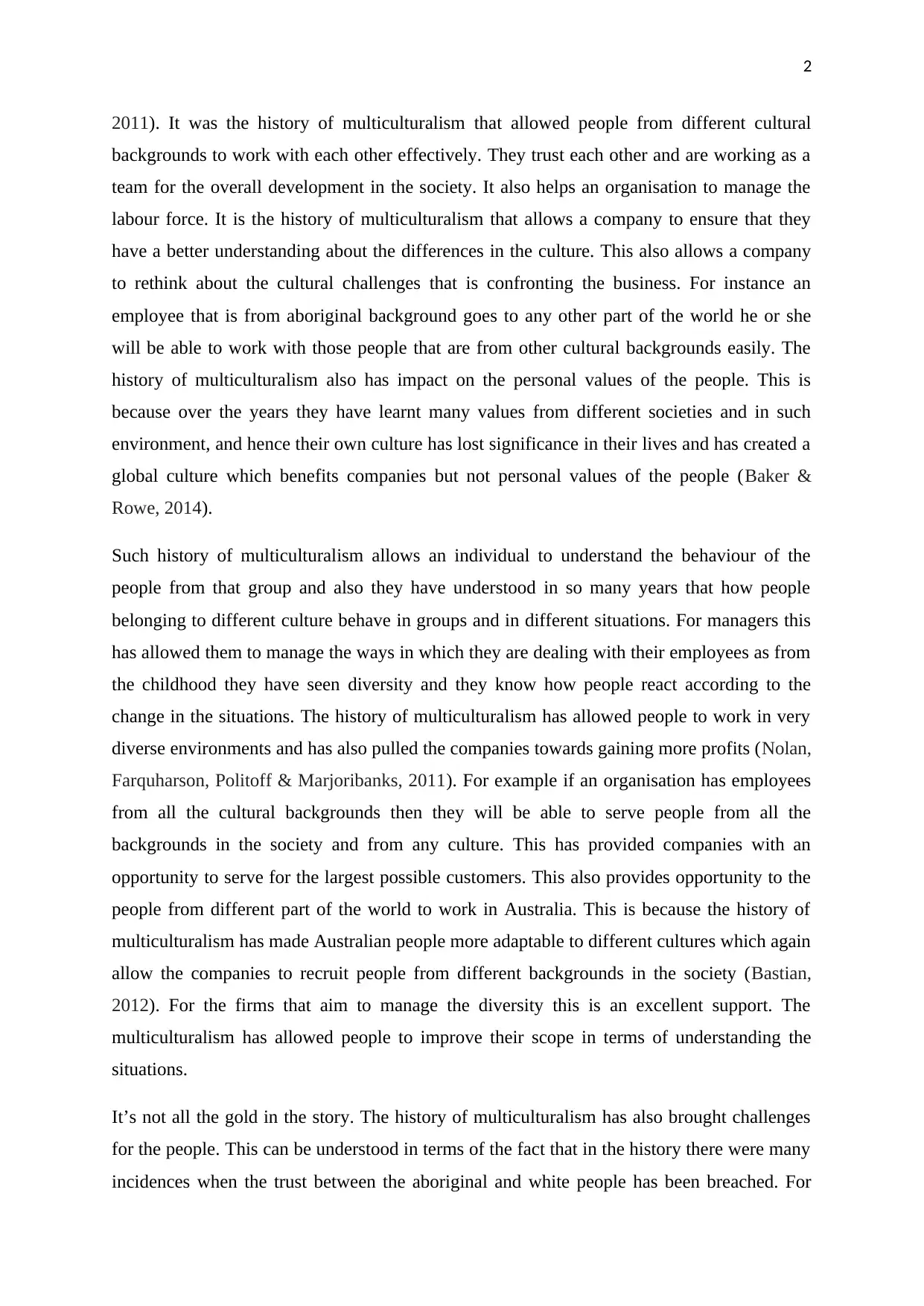
2
2011). It was the history of multiculturalism that allowed people from different cultural
backgrounds to work with each other effectively. They trust each other and are working as a
team for the overall development in the society. It also helps an organisation to manage the
labour force. It is the history of multiculturalism that allows a company to ensure that they
have a better understanding about the differences in the culture. This also allows a company
to rethink about the cultural challenges that is confronting the business. For instance an
employee that is from aboriginal background goes to any other part of the world he or she
will be able to work with those people that are from other cultural backgrounds easily. The
history of multiculturalism also has impact on the personal values of the people. This is
because over the years they have learnt many values from different societies and in such
environment, and hence their own culture has lost significance in their lives and has created a
global culture which benefits companies but not personal values of the people (Baker &
Rowe, 2014).
Such history of multiculturalism allows an individual to understand the behaviour of the
people from that group and also they have understood in so many years that how people
belonging to different culture behave in groups and in different situations. For managers this
has allowed them to manage the ways in which they are dealing with their employees as from
the childhood they have seen diversity and they know how people react according to the
change in the situations. The history of multiculturalism has allowed people to work in very
diverse environments and has also pulled the companies towards gaining more profits (Nolan,
Farquharson, Politoff & Marjoribanks, 2011). For example if an organisation has employees
from all the cultural backgrounds then they will be able to serve people from all the
backgrounds in the society and from any culture. This has provided companies with an
opportunity to serve for the largest possible customers. This also provides opportunity to the
people from different part of the world to work in Australia. This is because the history of
multiculturalism has made Australian people more adaptable to different cultures which again
allow the companies to recruit people from different backgrounds in the society (Bastian,
2012). For the firms that aim to manage the diversity this is an excellent support. The
multiculturalism has allowed people to improve their scope in terms of understanding the
situations.
It’s not all the gold in the story. The history of multiculturalism has also brought challenges
for the people. This can be understood in terms of the fact that in the history there were many
incidences when the trust between the aboriginal and white people has been breached. For
2011). It was the history of multiculturalism that allowed people from different cultural
backgrounds to work with each other effectively. They trust each other and are working as a
team for the overall development in the society. It also helps an organisation to manage the
labour force. It is the history of multiculturalism that allows a company to ensure that they
have a better understanding about the differences in the culture. This also allows a company
to rethink about the cultural challenges that is confronting the business. For instance an
employee that is from aboriginal background goes to any other part of the world he or she
will be able to work with those people that are from other cultural backgrounds easily. The
history of multiculturalism also has impact on the personal values of the people. This is
because over the years they have learnt many values from different societies and in such
environment, and hence their own culture has lost significance in their lives and has created a
global culture which benefits companies but not personal values of the people (Baker &
Rowe, 2014).
Such history of multiculturalism allows an individual to understand the behaviour of the
people from that group and also they have understood in so many years that how people
belonging to different culture behave in groups and in different situations. For managers this
has allowed them to manage the ways in which they are dealing with their employees as from
the childhood they have seen diversity and they know how people react according to the
change in the situations. The history of multiculturalism has allowed people to work in very
diverse environments and has also pulled the companies towards gaining more profits (Nolan,
Farquharson, Politoff & Marjoribanks, 2011). For example if an organisation has employees
from all the cultural backgrounds then they will be able to serve people from all the
backgrounds in the society and from any culture. This has provided companies with an
opportunity to serve for the largest possible customers. This also provides opportunity to the
people from different part of the world to work in Australia. This is because the history of
multiculturalism has made Australian people more adaptable to different cultures which again
allow the companies to recruit people from different backgrounds in the society (Bastian,
2012). For the firms that aim to manage the diversity this is an excellent support. The
multiculturalism has allowed people to improve their scope in terms of understanding the
situations.
It’s not all the gold in the story. The history of multiculturalism has also brought challenges
for the people. This can be understood in terms of the fact that in the history there were many
incidences when the trust between the aboriginal and white people has been breached. For
⊘ This is a preview!⊘
Do you want full access?
Subscribe today to unlock all pages.

Trusted by 1+ million students worldwide
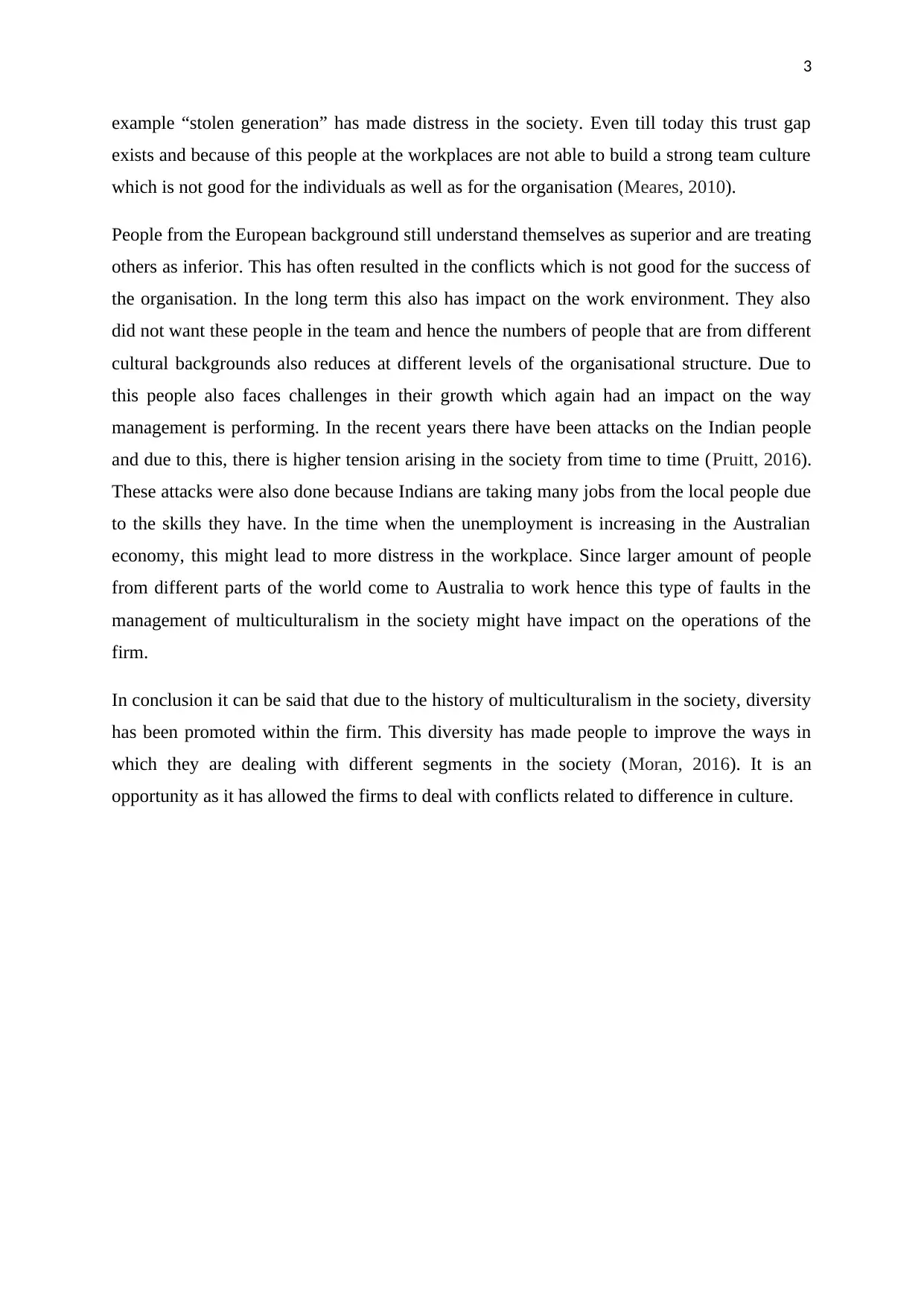
3
example “stolen generation” has made distress in the society. Even till today this trust gap
exists and because of this people at the workplaces are not able to build a strong team culture
which is not good for the individuals as well as for the organisation (Meares, 2010).
People from the European background still understand themselves as superior and are treating
others as inferior. This has often resulted in the conflicts which is not good for the success of
the organisation. In the long term this also has impact on the work environment. They also
did not want these people in the team and hence the numbers of people that are from different
cultural backgrounds also reduces at different levels of the organisational structure. Due to
this people also faces challenges in their growth which again had an impact on the way
management is performing. In the recent years there have been attacks on the Indian people
and due to this, there is higher tension arising in the society from time to time (Pruitt, 2016).
These attacks were also done because Indians are taking many jobs from the local people due
to the skills they have. In the time when the unemployment is increasing in the Australian
economy, this might lead to more distress in the workplace. Since larger amount of people
from different parts of the world come to Australia to work hence this type of faults in the
management of multiculturalism in the society might have impact on the operations of the
firm.
In conclusion it can be said that due to the history of multiculturalism in the society, diversity
has been promoted within the firm. This diversity has made people to improve the ways in
which they are dealing with different segments in the society (Moran, 2016). It is an
opportunity as it has allowed the firms to deal with conflicts related to difference in culture.
example “stolen generation” has made distress in the society. Even till today this trust gap
exists and because of this people at the workplaces are not able to build a strong team culture
which is not good for the individuals as well as for the organisation (Meares, 2010).
People from the European background still understand themselves as superior and are treating
others as inferior. This has often resulted in the conflicts which is not good for the success of
the organisation. In the long term this also has impact on the work environment. They also
did not want these people in the team and hence the numbers of people that are from different
cultural backgrounds also reduces at different levels of the organisational structure. Due to
this people also faces challenges in their growth which again had an impact on the way
management is performing. In the recent years there have been attacks on the Indian people
and due to this, there is higher tension arising in the society from time to time (Pruitt, 2016).
These attacks were also done because Indians are taking many jobs from the local people due
to the skills they have. In the time when the unemployment is increasing in the Australian
economy, this might lead to more distress in the workplace. Since larger amount of people
from different parts of the world come to Australia to work hence this type of faults in the
management of multiculturalism in the society might have impact on the operations of the
firm.
In conclusion it can be said that due to the history of multiculturalism in the society, diversity
has been promoted within the firm. This diversity has made people to improve the ways in
which they are dealing with different segments in the society (Moran, 2016). It is an
opportunity as it has allowed the firms to deal with conflicts related to difference in culture.
Paraphrase This Document
Need a fresh take? Get an instant paraphrase of this document with our AI Paraphraser
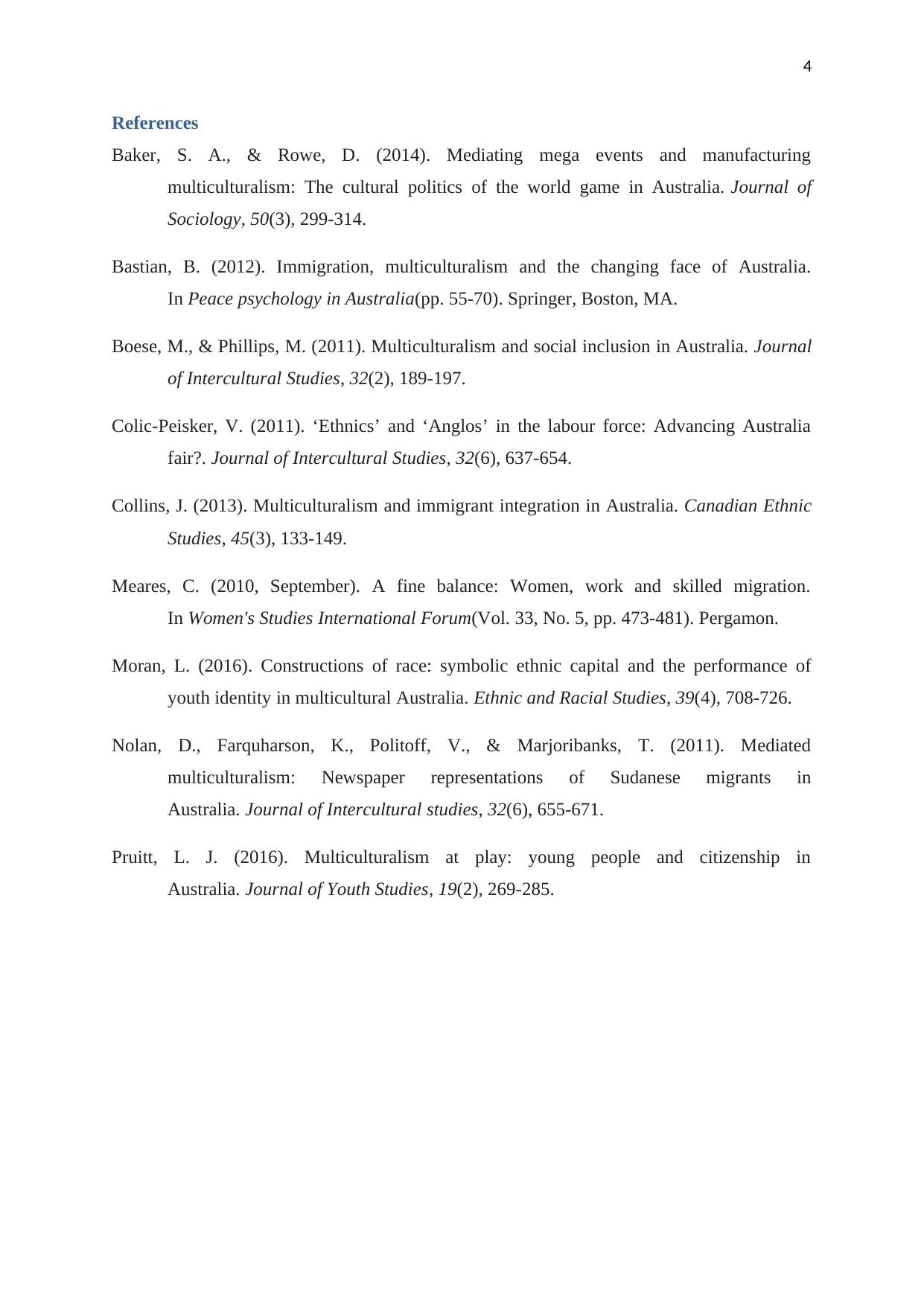
4
References
Baker, S. A., & Rowe, D. (2014). Mediating mega events and manufacturing
multiculturalism: The cultural politics of the world game in Australia. Journal of
Sociology, 50(3), 299-314.
Bastian, B. (2012). Immigration, multiculturalism and the changing face of Australia.
In Peace psychology in Australia(pp. 55-70). Springer, Boston, MA.
Boese, M., & Phillips, M. (2011). Multiculturalism and social inclusion in Australia. Journal
of Intercultural Studies, 32(2), 189-197.
Colic-Peisker, V. (2011). ‘Ethnics’ and ‘Anglos’ in the labour force: Advancing Australia
fair?. Journal of Intercultural Studies, 32(6), 637-654.
Collins, J. (2013). Multiculturalism and immigrant integration in Australia. Canadian Ethnic
Studies, 45(3), 133-149.
Meares, C. (2010, September). A fine balance: Women, work and skilled migration.
In Women's Studies International Forum(Vol. 33, No. 5, pp. 473-481). Pergamon.
Moran, L. (2016). Constructions of race: symbolic ethnic capital and the performance of
youth identity in multicultural Australia. Ethnic and Racial Studies, 39(4), 708-726.
Nolan, D., Farquharson, K., Politoff, V., & Marjoribanks, T. (2011). Mediated
multiculturalism: Newspaper representations of Sudanese migrants in
Australia. Journal of Intercultural studies, 32(6), 655-671.
Pruitt, L. J. (2016). Multiculturalism at play: young people and citizenship in
Australia. Journal of Youth Studies, 19(2), 269-285.
References
Baker, S. A., & Rowe, D. (2014). Mediating mega events and manufacturing
multiculturalism: The cultural politics of the world game in Australia. Journal of
Sociology, 50(3), 299-314.
Bastian, B. (2012). Immigration, multiculturalism and the changing face of Australia.
In Peace psychology in Australia(pp. 55-70). Springer, Boston, MA.
Boese, M., & Phillips, M. (2011). Multiculturalism and social inclusion in Australia. Journal
of Intercultural Studies, 32(2), 189-197.
Colic-Peisker, V. (2011). ‘Ethnics’ and ‘Anglos’ in the labour force: Advancing Australia
fair?. Journal of Intercultural Studies, 32(6), 637-654.
Collins, J. (2013). Multiculturalism and immigrant integration in Australia. Canadian Ethnic
Studies, 45(3), 133-149.
Meares, C. (2010, September). A fine balance: Women, work and skilled migration.
In Women's Studies International Forum(Vol. 33, No. 5, pp. 473-481). Pergamon.
Moran, L. (2016). Constructions of race: symbolic ethnic capital and the performance of
youth identity in multicultural Australia. Ethnic and Racial Studies, 39(4), 708-726.
Nolan, D., Farquharson, K., Politoff, V., & Marjoribanks, T. (2011). Mediated
multiculturalism: Newspaper representations of Sudanese migrants in
Australia. Journal of Intercultural studies, 32(6), 655-671.
Pruitt, L. J. (2016). Multiculturalism at play: young people and citizenship in
Australia. Journal of Youth Studies, 19(2), 269-285.
1 out of 5
Related Documents
Your All-in-One AI-Powered Toolkit for Academic Success.
+13062052269
info@desklib.com
Available 24*7 on WhatsApp / Email
![[object Object]](/_next/static/media/star-bottom.7253800d.svg)
Unlock your academic potential
Copyright © 2020–2025 A2Z Services. All Rights Reserved. Developed and managed by ZUCOL.




